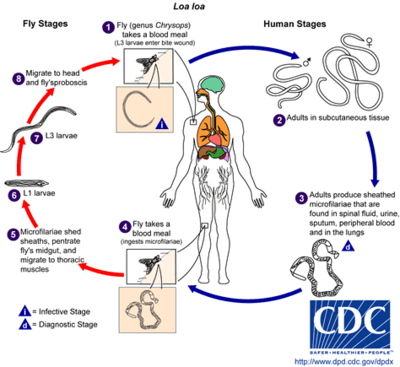Loa loa
| Loa loa | ||||||||||||
|---|---|---|---|---|---|---|---|---|---|---|---|---|

Microfilariae of Loa loa (right) and Mansonella perstans (left) in the same blood smear |
||||||||||||
| Systematics | ||||||||||||
|
||||||||||||
| Scientific name | ||||||||||||
| Loa loa | ||||||||||||
| Cobbold , 1864 |
Loa loa , also known as wandering filamentous or eye worm , is a nematode that parasitizes in humans in the subcutaneous fatty tissue andcausesthe clinical picture of loiasis (also known as "Cameroon bruises"). Since it also appears in the eye during its wanderings, it is known as an eye worm. The parasite is endemic to tropical Africa and is transmitted by horseflies from the genus Chrysops . Loa loa is one of the so-called neglected diseases .
features
The fully grown worms ( macrofilariae ) are whitish with a habitus typical of roundworms . The males are 30 to 35 mm long and about 0.4 mm in diameter. The female eye worms are 40 to 70 mm long and 0.5 mm thick. The microfilariae are only 300 µm long and are covered by a sheath.
distribution
The occurrence is limited to the tropical West and Central Africa between the 10th parallel north and the 5th parallel south, especially to the Democratic Republic of the Congo and the Republic of the Congo , Gabon , Chad , Sudan , the Central African Republic , Cameroon , Nigeria and Northern Angola .
Way of life
Loa loa lives as a parasitic nematode in the subcutaneous fatty tissue of its hosts. On its wanderings it also penetrates the eye and is visible there below the conjunctiva.
Host spectrum
In addition to humans, the host spectrum includes some African primate species such as the drill ( Mandrillus leucophaeus ), the Anubis baboon ( Papio anubis ) and the hussar monkey ( Erythrocebus patas ). Experimental infections are also possible in rodents, such as the Mongolian gerbil ( Meriones unguiculatus ).
Life cycle
Intermediate hosts and thus carriers are brakes of the species Chrysops dimidiata and Chrysops silacea . When sting (only the female horseflies suck blood), the filariae enter the skin as larvae in the L3 larval stage. It takes at least three months to develop into a fully grown, adult worm (macrofilariae). These worms then live in the subcutaneous fat tissue (subcutaneous fat tissue) and can move there at a speed of about 1 cm per minute. Their life expectancy can exceed 20 years.
The female filariae release their larvae (L1 stage) into the tissue as microfilariae, which then enter the blood via the lymph vessels . They are found mainly around noon (between 10 a.m. and 3 p.m.) in the blood vessels under the skin, where they can be absorbed by stinging horseflies. They are also sometimes found in the sputum , urine , cerebrospinal fluid and, especially at night, in the lungs .
After the microfilariae have been picked up by a horsefly, they strip off their vagina and penetrate the midgut. They go through two larval stages in the thoracic musculature and are transferred back to a human host as the L3 larval stage.
Diagnosis and treatment
The diagnosis is based primarily on the appearance of microfilariae in the blood (microscope), visible in the eye or on wandering skin swellings. On the one hand, the worm can be easily removed surgically, otherwise the usual treatment is carried out with worm poisons such as diethylcarbamazine , which specifically intervene in the metabolism of the parasites.
supporting documents
- ↑ Wolfram Gottfried Metzger, Benjamin Mordmüller: Loa loa — does it deserve to be neglected? In: The Lancet Infectious Diseases . tape 14 , no. 4 , April 2014, p. 353-357 , doi : 10.1016 / S1473-3099 (13) 70263-9 ( elsevier.com [accessed April 23, 2019]).
- ↑ Ramiro Morales-Hojas: Molecular systematics of filarial parasites, with an emphasis on groups of medical and veterinary importance, and its relevance for epidemiology. In: Infection, Genetics and Evolution 9 (5), September 2009; Pp. 748-759.
- ↑ a b C.D. Mackenzie, RR Suswillo, DA Denham: Survival of Loa loa following transplantation from drills (Mandrillus leucophaeus) into jirds (Meriones unguiculatus): parasitology and pathology. Transactions of the Royal Society of Tropical Medicine and Hygiene 76 (6), 1982; Pp. 778-782.
literature
- Article Loa loa and Loiasis In: Heinz Mehlhorn : Encyclopedic Reference of Parasitology. Biology, Structure, Function. Springer Verlag, Berlin, Heidelberg, New York 2001, ISBN 3-540-66239-1 .
